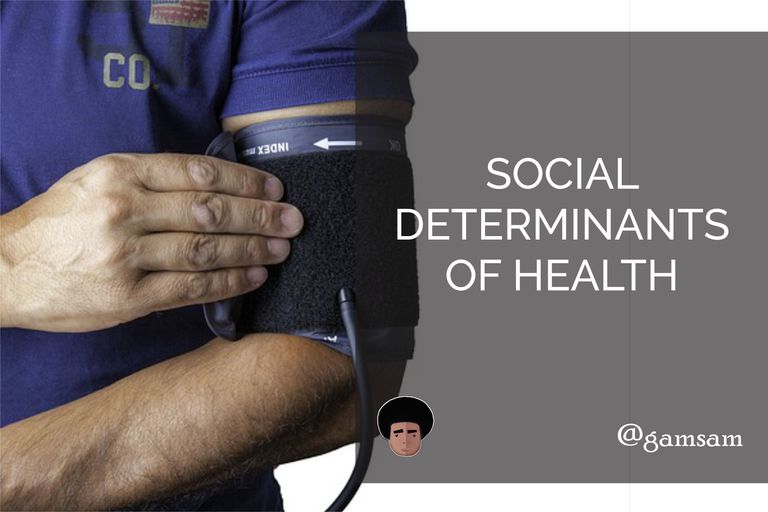Hello Blurt!
In today's article, we'll digress a little from clinical medicine to explore some parts of public health. This is because our health is also determined by the environment around us and public health addresses that. There are a lot of social factors that affects the health of humans and that is what we'll learn about today: The Social Determinants of Health.
Let's go.

Image created by @gamsam. Photo template source: Pixabay, Photographer: geraldoswald62
According to Braveman P. and Gottlieb L.,
The social determinants of health are the economic and social conditions that influence individual and group differences in health status. They are the health promoting factors found in one's living and working conditions, rather than individual risk factors that influence the risk for a disease, or vulnerability to disease or injury.
Efforts to improve health traditionally looked to the health care system as the key driver of health and health outcomes. Also, increasing access to health care and transforming the health care delivery system are important.
But researches demonstrate that improving population health and achieving health equity will require broader approaches that address social, economic and environmental factors that influence health.
The WHO later developed a Commission on Social Determinants of Health in 2005. The Commission aimed to draw the attention of governments and society to the social determinants of health and in creating better social conditions for health, particularly among the most vulnerable people. In 2008, it published a report entitled "Closing the Gap in a Generation“. This report identified two broad areas of social determinants of health that needed to be addressed.
- Daily living condition
- Distribution of power, money, and resources
The 2011 World Conference on Social Determinants of Health brought together delegations from 125 member states and resulted in the Rio Political Declaration on Social Determinants of Health. This declaration affirmed that health inequities are unacceptable It noted that these inequities arise from the societal conditions in which people are born, grow, live, work, and age.
Now, Social Determinants of Health, according to the World Health Organization is,
the circumstances in which people are born, grow up, live, work and age, and the systems put in place to deal with illness.
These circumstances are in turn shaped by a wider set of forces: economics, social policies, and politics.
The United States Centre for Disease Control defines Social Determinants of Health as:
life-enhancing resources, such as food supply, housing, economic and social relationships, transportation, education, and health care, whose distribution across populations effectively determine length and quality of life.
| Economic Stability ---> | Employment, Income, Expenses, Debt, Medical Bills, Support |
| Neighborhood and Physical Environment ---> | Housing, Transportation, Safety, Parks, Playgrounds, Walkability |
| Education ---> | Literacy, Language, Early Childhood Education |
| Food ---> | Hunger, Access to healthy options |
| Community and Social Context ---> | Social integration, Support systems, Community engagement, Discrimination |
| Health Care System ---> | Health Coverage, Provider availability, Provider linguistic and cultural competency, Quality of care |
Importance of Social Health Determinants
Social Health Determinants have direct impact on health; it predicts the greatest proportion of health status variance (health inequity), it structures health behaviour and interacts with each other to produce health.
Mechanism of Social Determinants
The UK Black and The Health Divide reports considered two primary mechanisms for understanding the process by which the social determinants influence health:
- Cultural/behavioural
- Materialist/structuralist
The cultural/behavioural explanation
Individuals' behavioural choices (e.g., tobacco and alcohol use, diet, physical activity, etc.) responsible for their developing and dying. Behavioural choices are heavily structured by one's material conditions of life. These behavioural risk factors account for a relatively small proportion of variation in the incidence and death from various diseases.

Source: Pixabay| Artist: Angela_Yuriko_Smith
The materialist/structuralist explanation
It emphasizes the material conditions under which people live. These conditions include: Availability of resources to access the amenities of life, Working conditions, Quality of available food Housing among others
Impact on Health
Economic well-being is one of the most critical determinants of health; living in poverty is associated with significantly worse health outcomes across all races and ethnicities and in every state and community.
Unemployment is associated with poor physical and mental health outcomes.
A report from the Robert Wood Johnson Foundation states that:
The means by which poverty damages health over the life course are many, but key elements involve limits on opportunity and participation that come directly from inadequate financial resources, diminished early life environments and poor educational opportunities.
Physical environments that are dangerous and under-resourced, poor working conditions, absence of benefits, job insecurity, lack of health insurance and access to quality medical care, and acute and chronic stress.
Education is another key determinant of health; education and health correspond closely and impact each other in both directions. People with higher levels of educational attainment consistently experience lower risks for a wide array of illnesses and increased life expectancy.
They also experience improved future economic well-being. In turn, educational attainment itself is shaped by health. For example, the health of students significantly impacts school dropout rates, attendance, and academic performance.

Source: Pixabay | Photographer: picjumbo_com
Neighborhood characteristics have significant impacts on health outcomes because they influence an individual’s ability to adopt behaviors that promote health. Efforts to change behaviors that impact health are most effective when they also address the environments in which people make their daily choices.
For example, People whose neighborhoods lack parks, green open spaces, or trees and whose neighborhoods have high crime rates, have less access to safe places to play or walk. People in low-income neighborhoods often have less access to affordable, healthy food retail options, and have more access to cheap fast-food outlets. Rates of violence, crime and interpersonal violence are higher in neighborhoods with a high density of alcohol outlets.
The social condition of autonomy, control, and empowerment also influences health and disease. Individuals who lack social participation and control over their lives are at a greater risk for heart disease and mental illness.
The fight-or-flight reaction (which is chronically elicited in response to threats such as income, housing, food insecurity among others) weakens the immune system, leads to increased insulin resistance, causes greater incidence of lipid and clotting disorders and other biomedical insults that are precursors to adult disease.
Comparisons to those of a higher social class can also lead to attempts to alleviate such feelings by overspending and taking on additional employment that threaten health.
Chronic stress has been found to be significantly associated with chronic low grade inflammation, slower wound healing, increased susceptibility to infections and even poorer responses to vaccines.
For example, a study of otherwise healthy adult males found that those with high levels of perceived stress in their lives had significantly longer wound healing times. That elevated cortisol levels (which is secreted during prolonged periods of stress), rather than health behaviour responses, appeared to be the main reason for this relationship.

Source: Pixabay
Chronic stress is common in those of a low socio-economic status, who have to balance worries about financial security, feeding their families, housing, etc. Many other concerns are likely to to be prioritized above their health.
At the individual level, the perception and experience of one's status in unequal societies lead to stress and poor health. Feelings of shame, worthlessness and envy can further lead to harmful effects on Neuro-endocrine, Autonomic and Metabolic, and Immune systems.
Discrimination can result in:
- Mental health impacts (including stress, anxiety and depression)
- Violence, including intimate partner violence
- Raised blood pressure
- Poorer self-rated health
- Chronic health conditions
- Delay or failure to seek treatment, including preventive care
- Substance abuse
Improving Social Determinants of Health
The WHO Commission on the social Determinants of Health states that there are three important factors that will improve the social determinants of health and they are:
- Improving daily condition by: Early childhood development, affordable housing and quality health care services.
- Tackling the inequitable distribution of power, money, and resources:
How?
The responsibility for health should be at the highest level of government and coherence of policies should be across all sectors. - Measuring and understanding the problem and assessing the impact of action by: creating monitoring systems for health at all levels and sharing of new evidence.
These recommendations would involve providing resources such as quality education, decent housing, access to affordable health care, access to healthy food, and safe places to exercise for everyone despite gaps in affluence.
In the Rio Political Declaration on Social Determinants of Health, several key areas of action were identified to address inequalities:
- Promotion of participatory policy-making processes
- Strengthening global governance and collaboration
- Addresses the social determinants of health leading to persistent health inequalities for indigenous peoples.
Reducing the health gap in a generation requires that governments build systems that allow a healthy standard of living where no one should fall below due to circumstances beyond his or her control.
Social protection schemes can be instrumental in realizing developmental goals rather than being dependent on achieving those goals. They can be effective ways to reduce poverty and local economies can benefit.
Conclusion
Social determinants of health influence health-promoting behaviours, health equity among the population is not possible without equitable distribution of social determinants among groups and it can be achieved by closing the gap in a generation.
Do you have any questions, concerns or anything to add? Tell me what you think below.
Do you have any questions, concerns or anything to add? Tell me what you think below.

Resources
- Braveman, P. and Gottlieb, L., 2014. The social determinants of health: it's time to consider the causes of the causes. Public health reports, 129(1_suppl2), pp.19-31.
- Commission on Social Determinants of Health (2008). Closing the Gap in a Generation: Health Equity Through Action on the Social Determinants of Health (PDF). World Health Organization. ISBN 978-92-4-156370-3.
- World Conference on Social Determinants of Health (2011). "Rio Political Declaration on Social Determinants of Health“ (PDF). World Health Organization.
- Lindan R, Julia C, Karen BM, Lianne D, Health in All Policies. Available from: https://www.apha.org>pdf>factsheet.
- Ebrecht, Marcel; Hextall, Justine; Kirtley, Lauren-Grace; Taylor, Alice; Dyson, Mary; Weinman, John (2004). "Perceived stress and cortisol levels predict speed of wound healing in healthy male adults". Psychoneuroendocrinology.


Written by @gamsam - a Medical Student
All images used are copyright free
Vancouver Style was used for References.
Hey @gamsam, I really enjoyed reading your post, It's great to know that the factors are starting to be highlighted that affect our health from research.
The next step how does one change these elements in their own life?
If one is not open to change, options or to helping ones self how can someone else help them.
Congratulations, your post has been curated by @blurthealth, manually curated by @ninoh22. To get more Upvote support, make more unique health related content and follow @blurthealth.